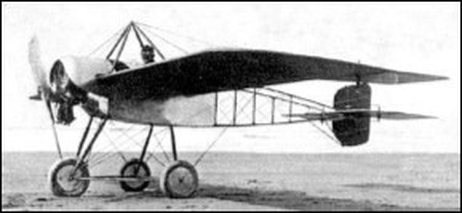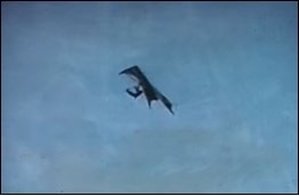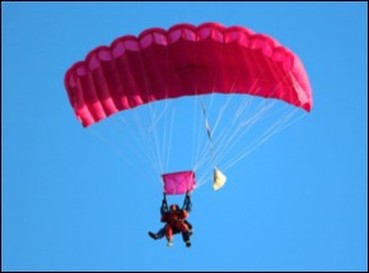Looping Ad Nauseam (Aug 2016)

Adolphe Pégoud thought he was the first man to perform a loop in an aeroplane.
He had earned his licence on 8 February 1913 and was keen to do something spectacular in flying. He wanted to do a parachute jump but no-one would take him up in a two-seat aeroplane. Everyone believed that a person jumping out of a plane would so upset the balance that it would crash. Pégoud overcame this hurdle by jumping out of his own Bleriot. Climbing to 2,000 ft he stepped out and his parachute opened perfectly. His descent was a little fraught as his Bleriot reared and tumbled about him but he landed safely in a tree. The Bleriot crashed nearby.
He had earned his licence on 8 February 1913 and was keen to do something spectacular in flying. He wanted to do a parachute jump but no-one would take him up in a two-seat aeroplane. Everyone believed that a person jumping out of a plane would so upset the balance that it would crash. Pégoud overcame this hurdle by jumping out of his own Bleriot. Climbing to 2,000 ft he stepped out and his parachute opened perfectly. His descent was a little fraught as his Bleriot reared and tumbled about him but he landed safely in a tree. The Bleriot crashed nearby.
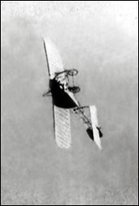
This expensive exploit brought some reward. Bleriot employed him to demonstrate his latest design, the 50 hp Model XI. Fitted with a strong shoulder harness (any kind of harness was unusual at that time) he flung the Bleriot about in a variety of manoeuvres, steep dives, 90° banks, even a brief spell of inverted flying, which he didn’t enjoy because he was liberally sprinkled with petrol streaming out of the air hole on the top of the tank. Later flights included tail slides, ‘flick’ turns and a vertical figure ‘S’. Experimenting with ways to recover from a steep dive he pulled back the control to climb and daringly held it back until he had completed his first loop.
He was immediately acclaimed as being the world’s first pilot to have ’looped the loop’. Later, it emerged that on 9 September, just twelve days before Pégoud’s exploit, Pyotr Nesterov of the Imperial Russian Army, had looped his Nieuport IV in the skies over Kiev. (He was initially arrested for endangering army property but quickly released and promoted to Captain). Poor old Adolphe. He wasn’t even the first man to parachute from an aeroplane. That feat had been performed in March 1912 in the USA.
He was immediately acclaimed as being the world’s first pilot to have ’looped the loop’. Later, it emerged that on 9 September, just twelve days before Pégoud’s exploit, Pyotr Nesterov of the Imperial Russian Army, had looped his Nieuport IV in the skies over Kiev. (He was initially arrested for endangering army property but quickly released and promoted to Captain). Poor old Adolphe. He wasn’t even the first man to parachute from an aeroplane. That feat had been performed in March 1912 in the USA.

Nevertheless, it was Pégoud’s fame which spread to America and, more particularly, to Lincoln Beachey. He performed outrageous stunts in cars, then, when he learned to fly, in aeroplanes. He became a member of Glenn Curtiss’s exhibition team, raced a train and ran his wheels along the roof of a carriage. He took off, flew ‘at 60 mph’ and landed, inside an exhibition hall at the San Francisco World Fair. He flew at night, releasing flares and ‘bombs’. He filled his fuel tanks to the brim and climbed until the fuel ran out and the engine stopped, gliding down from 11,578 feet having beaten the world altitude record. One of his most frightening tricks was a powered vertical dive with a dangerously low recovery. A friend tried to emulate this and was killed. Beachey was horrified by this and other deaths which he believed had been the result of people imitating his stunts and vowed to retire from aviation.
The ‘retirement’ lasted three months, until the news of Pégoud’s loop inspired him to fly again. He persuaded Curtis to build him a plane strong enough to attempt the loop and took it up for testing. On its first flight, the wing tip clipped a tent pole and the plane swerved, its wing sweeping a number of spectators off a roof. One woman died and others were injured. Beachey decided he was wrong to come out of retirement.
He was a widely publicised hero but quickly found that he couldn’t persuade people to pay to watch him when they could see just as well from outside the field. He retired for the third time.

However - his manager had a plan. He found a car racing circuit surrounded by a high fence where the paying public could watch the famous Barney Oldfield race his car against the low-flying Lincoln Beachey. The plan worked and they began making money.

Beachey got a new plane, which he called ‘Little Looper’ and as his fame spread, he was in demand for many exhibitions and displays. Naturally, loops were at the core of all his shows. Other pilots were learning to loop, of course, some doing multiple loops in the same flight. Beachey silenced the opposition with a remarkable performance of eighty continuous loops.
Aiming for more spectacular aerobatics and inverted flight he acquired a faster mount, the Beachey Eaton Monoplane. Its first public display was to be at the Panama-Pacific International Exposition in San Francisco on 14th March 1915. 50,000 spectators in the fairground – and another 200,000 in the surrounding hills - watched him fly his monoplane inverted across the bay. With only 2,000 ft to recover, he pulled back the control – too hard, and the rear wing spars shattered. The wreckage fell between two ships but, when his body was recovered, he had drowned. His funeral was said to be the largest in San Francisco’s history.
The urge to do multiple loops didn’t die with Beatty. By 1930 the American record stood at 344, held by Miss Laura Ingalls. She was some way behind the world record. In France Mlle. Adrienne Bolland had raised the record to just over 700. But it was a feat no longer making any headlines and the sheer numbers challenge seems to have been replaced by number of loops in a specific time. A Swedish record of 256 loops in one hour was beaten in 1992 by a Finn who managed 372 in his 60 hp Fournier RF-4 motor glider. Interestingly, he started at only 1500 ft above the ground. Although there was no official recording of this feat and other multiple loops there are still aerobatic records in specialised categories. One, still current, was set as long ago as 1958.

When preparing for the Farnborough Air Show, Sqn Ldr Roger Topp, CO of 111 Sqn’s Hunter formation team, knew that the Pakistan Air Force had looped a formation of 16 NA Sabres. He wanted to do better than that and began practising looping 20 Hunters in five lines of four. The fourth aircraft in each line found it difficult to maintain position at the top of the loop so the formation was changed to seven lines of three. The final tweak was to improve the look of the formation by adding one Hunter behind the centre line. In the event, the 22 Hunters opened their display at Farnborough with two loops in formation, setting a record which has never been beaten.
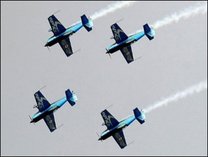
Not by numbers of aircraft involved, certainly, but the Black Arrows did only two consecutive loops. That aspect of their record could easily be outdone. So when the Blades formation team, based at Sywell, were approached by Mike Newman, they seized the opportunity. Mike is blind and determined to hold records for driving racing cars and speedboats. To complete the land-sea-air trio the Blades taught Mike to fly a loop in an Extra 300. On 20th October 2011 the team formatted on Mike as he flew his loop then his ‘co-pilot’ Myles Garland took over and they went on to complete 26 consecutive formation loops, a world record officially verified by the FAI..
There is another category of looping record breaking that adds a different element of difficulty. Gliders loop well and derive sufficient energy for the manoeuvre by converting altitude into speed. So the number of loops they can do depends on the starting altitude. In the 1930s Jack O’Mears was towed to 12,000 ft over Roosevelt Field and managed 46 loops before he deemed it wise to level off at 500 ft above the ground.
Then an RAF officer, Sqn Ldr Edward Mole, who was stationed in Egypt, got involved. Already a keen glider pilot, he had found a small gliding club (run by a Hungarian who had been a fighter pilot with the Germans in WWI). They were using a winch to launch primary gliders. They had a better glider, a German-made Wulf, but it was little used. Mole persuaded his tolerant CO to fit a bomb release to the tail of an Avro Tutor and with this the Wulf was launched on the first aero-tow in Egypt. Mole knew that his friend, Robert Kronfeld, had previously done 65 continuous loops. He took the Wulf up to 8,000 ft and raised the total to 67. It was not a record. An American held that with 85 loops.
Then an RAF officer, Sqn Ldr Edward Mole, who was stationed in Egypt, got involved. Already a keen glider pilot, he had found a small gliding club (run by a Hungarian who had been a fighter pilot with the Germans in WWI). They were using a winch to launch primary gliders. They had a better glider, a German-made Wulf, but it was little used. Mole persuaded his tolerant CO to fit a bomb release to the tail of an Avro Tutor and with this the Wulf was launched on the first aero-tow in Egypt. Mole knew that his friend, Robert Kronfeld, had previously done 65 continuous loops. He took the Wulf up to 8,000 ft and raised the total to 67. It was not a record. An American held that with 85 loops.

The answer arrived early in 1938. The gliding club bought a new sailplane built by the Budapest Technical College, the M22, named ‘Turul’ – Arabic for the mythical bird, the Roc. It was fully stressed for aerobatics and Mole tested it thoroughly, even managing to do a difficult outside loop. He realised this had little impact on spectators but, more significantly, he learned of the death of a friend who was trying the same when his wings collapsed. Mole turned back to the continuous looping record. The Tutor could not get him high enough so the ever-cooperative CO had the hook fitted to a Hawker Audax.

On 12 April 1938 the Audax towed the Turul as high as it could, taking 45 minutes to reach 15,400 ft. Mole released the cable and began looping. Each loop took about ten seconds and Mole began to feel that he was stationary and the earth and sky were looping round him. After 25 minutes he was down to 500 ft and he stopped looping, although the world was still revolving round him. Unable to find the airfield he landed on a conveniently smooth part of the desert. Climbing out of the cockpit he immediately fell over backwards.
The official observers landed nearby. They – and Mole’s sealed barograph – confirmed that he had easily captured the world record with 147 loops. Mole was quite sure that no-one else would be stupid enough to break it. A few days later there was an accident at the gliding school and a pupil was killed. The authorities grounded all gliders and stopped all gliding operations.
The official observers landed nearby. They – and Mole’s sealed barograph – confirmed that he had easily captured the world record with 147 loops. Mole was quite sure that no-one else would be stupid enough to break it. A few days later there was an accident at the gliding school and a pupil was killed. The authorities grounded all gliders and stopped all gliding operations.
Hang gliders (that’s the sports kind, not those of the pioneering Otto and Percy) developed from the Rogallo wing which was intended to retrieve spacecraft. They were not particularly manoeuvrable. The pilots hung from their gliders on a flexible cord and the brave hopefuls trying to loop usually went so slow over the top that they fell onto the inverted wing. The first to succeed was a Frenchman called Rudy Kishazy. He realised that he would need maximum effort to push the bar as far forward as he could. He planned to stand on the bar with his feet in canvas loops, adding power to his push and preventing him from falling into the inverted wing. Flying over the mountains near Chamonix in 1976 he succeeded in being first to complete a hang glider loop and these stills from an indifferent video prove it.
Hang gliders developed quickly. The chord was shortened and efficient wing sections improved performance greatly. Looping was no problem and the number of successive loops grew, all recorded in the Guinness Book of World Records. 24, 33, 40 and by 1988 John Heiney held the record with 52 loops. This was done after being carried aloft by a balloon, much preferred by hang gliders pilots because they start looping with rested arms. Balloon pilots became increasingly reluctant to cope with the antics of their balloons after the sudden loss of weight at high altitudes but the power of tugs was increasing and Heiney decided to attack his own 9 year old record.
On the last day of 1997 conditions over Florida were favourable and he was towed to 12,000 ft. He was wearing three layers of clothing and ice climbing mittens, each with two heat packs. Being somewhat out of condition he felt the muscle strain of controlling the glider during the long tow. The frenzy of tight loops and repetitive pulling of ‘g’ lasted just six minutes. Approaching the ground he could see that he was dangerously close to some power lines. The last loop ended at 500 ft and in the gusty surface wind he had to avoid houses and the power lines to find a landing spot.
His loops had been counted by ground observers and his tug pilot who kept up with him by diving at 60 mph. The total was 56, enough for another Guinness entry. However, the National Aeronautic Association told him that they and the FAI would no longer recognise looping records to discourage more dangerous attempts.

The lack of ‘official’ recognition didn’t deter Chad Elchin. On 16 July, 2001 he took a tow to 15,900 ft over Maryland, USA. He looped his Aero Stealth Combat down to 700 ft setting a new record of 95 loops. Unofficial it might be, but it seems to be enough to close the book on multiple looping attempts.
Probably – unless we look at another style of flying. Parachutists got more fun than mere jumping when they introduced some means of lateral control during a descent. In the 1960s, the chutes changed shapes as multi-cells inflated by ram air were introduced to improve glide performance. The latest canopies are now wing-shaped and modern paragliders have glide ratios which are comparable with light aircraft. They are very controllable, carrying out extensive soaring flights and demonstrating tight-turning aerobatic manoeuvres. But looping? With all the weight concentrated in the pilot, how could they possibly fly upside down?
They can do something more remarkable. It seems that they start with a steep spiral to the left, turning rapidly. Then they straighten up and apply the brakes. That’s the wing which slows down. The pilot swings forward and if he’s timed it correctly, he swings right over the canopy. Once started, the rotation keeps going with the pilot exceeding 4G at the bottom of every tumble. The manoeuvre’s much quicker than a loop and it’s got a splendid name – it’s called the infinity tumble.
Inevitably, there’s a record, currently held by Horacio Llorens. His cousin invented the move and set the first record in 2006 – 108 ‘loops’. After that the record rose to 211, then 281, 374 and 392. They seemed to be trying to reach infinity.
Inevitably, there’s a record, currently held by Horacio Llorens. His cousin invented the move and set the first record in 2006 – 108 ‘loops’. After that the record rose to 211, then 281, 374 and 392. They seemed to be trying to reach infinity.

Horacio was sponsored by Red Bull who provided a helicopter to take him to 19,700 ft. They chose to do the flight on 21 December 2012 which you will remember is the date when the Mayans said the world would end. That’s why they went to Guatemala for the ultimate record.
At the peak of the climb, Horacio took off his oxygen mask and stepped out. In the next 15 minutes he looped 568 times, recovering at 1500 ft because he ‘felt the ground was getting close’.
That might not be looping ad infinitum but it’s certainly looping ad nauseam.
If you’d like to see Horacio in action, go to https://www.youtube.com/watch?v=P9c0zWkLZ6c




